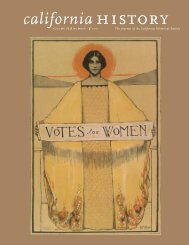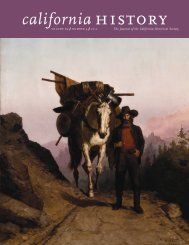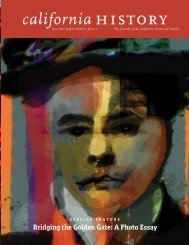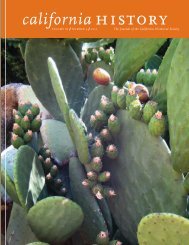Volume 90, Number 1 - California Historical Society
Volume 90, Number 1 - California Historical Society
Volume 90, Number 1 - California Historical Society
Create successful ePaper yourself
Turn your PDF publications into a flip-book with our unique Google optimized e-Paper software.
36<br />
Some priests wanted to experience, rather than<br />
write about, the chance to fight on God’s behalf.<br />
When Father Miguel Hidalgo led Mexico’s fight<br />
for independence in 1810, he unfurled banners<br />
upon which his followers had emblazoned an<br />
image of the Virgin of Guadalupe. Rallying his<br />
troops, he proclaimed that all should align themselves<br />
with God and deliver Mexico from the<br />
Spaniards who had fallen sway to the anti-Catholic<br />
ideas of the French Revolution. 69 José María<br />
Morelos, another rebel priest, proved quite adept<br />
at guerrilla warfare, and in 1813 he approved the<br />
Constitution of Chilpancingo that recognized<br />
Catholicism as the supreme faith of Mexico. 70<br />
Priests in <strong>California</strong> seemed no less vigorous. 71<br />
In 1810, Father José Viader twice accompanied<br />
expeditions from Mission San José to capture<br />
Indian converts who had escaped. Viader draws<br />
no distinction between himself and the soldiers.<br />
In all instances, he indicates “we” to show he<br />
participated in every activity. On one expedition,<br />
Viader, “in the company of Lieutenant<br />
Gabriel Moraga, 23 other soldiers, and about 50<br />
armed Christian Indians,” describes an attack<br />
on an Indian village to apprehend runaway<br />
neophytes. “We placed our people in position<br />
to attack a dance [being carried on] by heathen<br />
Indians and fugitive Christians,” he noted in his<br />
report. At dawn, the next day, “we assaulted a village<br />
. . . [and] . . . took it entire. The prisoners in<br />
all included 15 San José Christians, 18 heathen<br />
men, and 51 heathen women.” 72<br />
In a few cases, priests commanded troops in<br />
the field, or at least seemed quite comfortable<br />
about conducting themselves as soldiers. In<br />
1816, Father Juan Luís Martínez, rector of Mission<br />
San Luis Obispo, led an expedition into<br />
the southern part of <strong>California</strong>’s Central Valley.<br />
It is not clear how many men joined him, but<br />
whatever the number, they obeyed the priest’s<br />
orders to round up fugitive converts and pagan<br />
Indians so that they could learn of the “True God,<br />
without [whom] no one can live well or enjoy<br />
<strong>California</strong> History • volume <strong>90</strong> number 1 2012<br />
any good fortune.” Returning home, Martínez<br />
and his companions visited a village they had<br />
called upon during the first part of their journey.<br />
But the village had moved, and Martínez, who<br />
“was . . . astonished at their fickleness,” ordered<br />
his men to look for the settlement. When they<br />
found the village, the Indians attacked. Martínez<br />
is not clear about the succeeding chain of events,<br />
but he adds that the “next day the village was<br />
burned and everything in it destroyed because<br />
the people in it had taken up arms against<br />
those [the priest and his men] who had treated<br />
them well. . . . This village [deserved] severe<br />
punishment.” 73<br />
In 1817, Father Narciso Durán, as rector at Mission<br />
San José, asked Governor Pablo de Solá for<br />
permission to pursue fugitive neophytes. Durán<br />
explained that his “breviary” and santo cristo<br />
(image of Jesus Christ) would serve, in Hubert<br />
Bancroft’s paraphrase, as “weapons.” In case<br />
these sacred instruments failed, Durán requested<br />
a cañóncito (little cannon) to convince the fugitives<br />
to return to the mission. 74 Meanwhile,<br />
Father Xavier de la Concepción Uría demonstrated<br />
that he could acquit himself well in battle.<br />
During the Chumash rebellion in 1824, Uría,<br />
then rector at Mission Santa Inés, awoke from a<br />
nap as insurgents approached his quarters. A witness<br />
recalled he jumped out of bed and “shot and<br />
killed” two Indians with his shotgun. 75<br />
The exploits of bellicose priests and their contemporaries<br />
abided by patterns that long had<br />
presented war as a sacred endeavor. Given the<br />
practices bequeathed them by medieval Spain,<br />
the priests and settlers of <strong>California</strong> drew upon<br />
ideas that enabled them to define and overcome<br />
an enemy’s defiance. When contesting<br />
Indians and the pirate Hippolyte Bouchard,<br />
individuals who imperiled the very nature of<br />
their existence—Bouchard supposedly professed<br />
the atheism of the French Revolution and thus<br />
threatened the sanctity of religion—they consecrated<br />
war. But when the residents of Mexican









